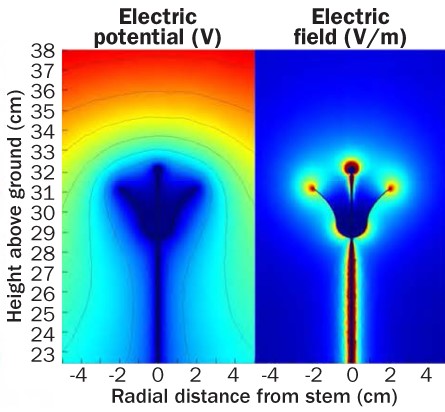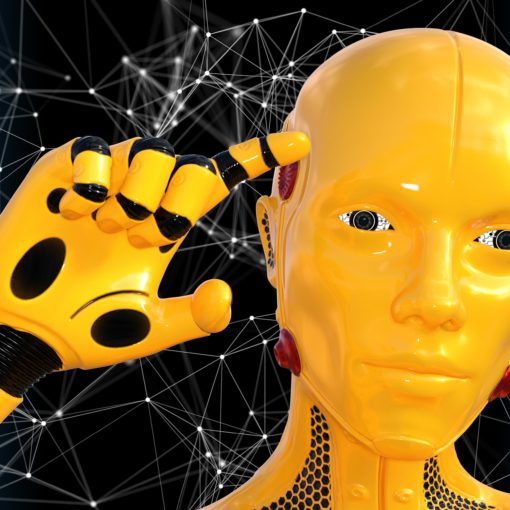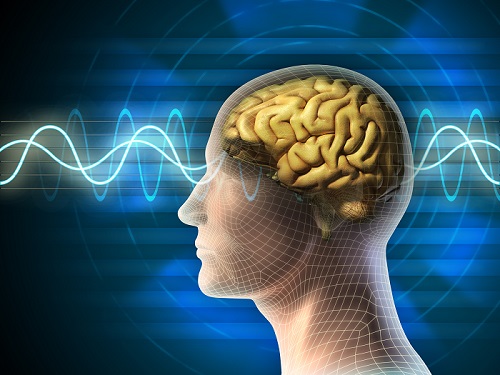 The fact that living beings are surrounded by an electric field should not come as any surprise, as every living cell can be described as generating electricity. Early in the twentieth century, the Indian biologist J. C. Bose published a series of books in which he demonstrated the significant role that electricity plays in the growth and development of plants and animals. 1 2 Bose believed that plants had a nervous system, located in the phloem of cells, that allowed the transmission of electrical signals throughout the organism. He believed that plants could even have emotions. His work fell into obscurity, with the rise of biochemistry and the fashion for chemical signals as being most important. However, it has been recently re-discovered and forms the basis of new research known as plant neurobiology.
The fact that living beings are surrounded by an electric field should not come as any surprise, as every living cell can be described as generating electricity. Early in the twentieth century, the Indian biologist J. C. Bose published a series of books in which he demonstrated the significant role that electricity plays in the growth and development of plants and animals. 1 2 Bose believed that plants had a nervous system, located in the phloem of cells, that allowed the transmission of electrical signals throughout the organism. He believed that plants could even have emotions. His work fell into obscurity, with the rise of biochemistry and the fashion for chemical signals as being most important. However, it has been recently re-discovered and forms the basis of new research known as plant neurobiology.
As a healer who practices Therapeutic Touch, I have often wondered about the nature of the field that the human hand is sensitive to when exploring the field of a patient. Sensations, felt a few inches away from the body, include heat, cold or a tingling. Often those sensations can help locate pain or some other infirmity. But what kind of field is it? One of the most likely candidates for such a field is the electric field that every organism generates, and which J. C. Bose described. Its properties were researched and described in many papers published by H. S. Burr of Yale University Department of Medicine. 3 Back in 1968, Andrew Głazewski, one of the co-founders of the SMN, published a paper in the London Hospital Gazette 4 in which he explained the workings of the healing hand in terms of changes to the body’s electric field.
It appears that Bumble Bees are also adept at detecting a flower’s electric field, and use that information to detect whether a flower has already been visited by other bees. A recent study 5 conducted by Dominic Clarke and others at the University of Bristol showed that Bumble Bees respond to the electrical field surrounding a flower. Flying bees carry an electric charge that can be measured. 94% of the bees were found to carry a positive charge of 5pC. Flowers carry a negative charge (relative to the atmosphere), that changes after a bee visits the flower. So — the flower’s field changes due to pollination. Apparently bees detect that change before they even land on the flower, and know that the flower is unlikely to have nectar.
To demonstrate this, researchers created artificial flowers similar to those visited by bees, but substituted quinine instead of nectar. At first, the bees visited flowers at random. However, after the researchers applied a voltage to the flowers, to create a field that mimicked what is found in nature, the bees expressed a strong preference for visiting those flowers. The researchers then varied the shape of the electric field around artificial flowers and they found that bees tended to visit flowers with concentric fields rather than elongated fields. The authors concluded that bees sense the electric field of the flower, and use that information to determine whether the flower is likely to have nectar.
If bees have the ability to detect electric fields, what about human hands? Many of us have noticed that the hairs on our arms respond to a strong electric field, but what about weak fields, the sort that are typically found in nature, or that surround a human being? Recent research by Min Zhao and others6 at UC David suggest that living cells are equipped with a two molecule sensing mechanism for electric fields, suggesting that our sense of touch extends to detecting electric fields. If bees, as this study shows, can detect electric fields, why shouldn’t people?
by Paul Kieniewicz
References
- C. Bose, Comparative Electro-physiology, Longmans Green, 1907
- C. Bose, Response in the living and Nonliving, Longmans Green 1922
- S. Burr, Blueprint for Immortality, publ. Neville Spearman, 1972, 192p
- Glazewski, Can there be any science behind healing hands? London Hospital Gazette, 1967, reprinted in Harmony of the Universe, by Kieniewicz and Glazewski, White Crow Books, 2014.
- Dominic Clarke, Heather Whitney, Gregory Sutton, Daniel Robert, Detection and Learning of Floral Electric Fields by Bumblebees Science, 340, p66-69, 2013.
- Nakajima K, Zhu K, Sun YH, Hegyi B, Zeng Q, Murphy CJ, Small JV, Chen-Izu Y, Izumiya Y, Penninger JM, Zhao M KCNJ15/Kir4.2 couples with polyamines to sense weak extracellular electric fields in galvanotaxis, Nat Commun. 2015 Oct 9;6:8532





One thought on “Plant Fields and the Bumble Bee”
Hi Paul
As a bee keeper, thanks for a great article.
May I also recommend a couple more classic books on the subject? By people who also did pioneering work on the practical applications of bioelectricity for healing and chemical-free pest control.
“Tuning In To Nature : Infrared Radiation and the Insect Communication System” (1975)
“The Body Electric: Electromagnetism and the Foundation of Life” by Robert Becker (1998)
Regards
Keith MacDonald